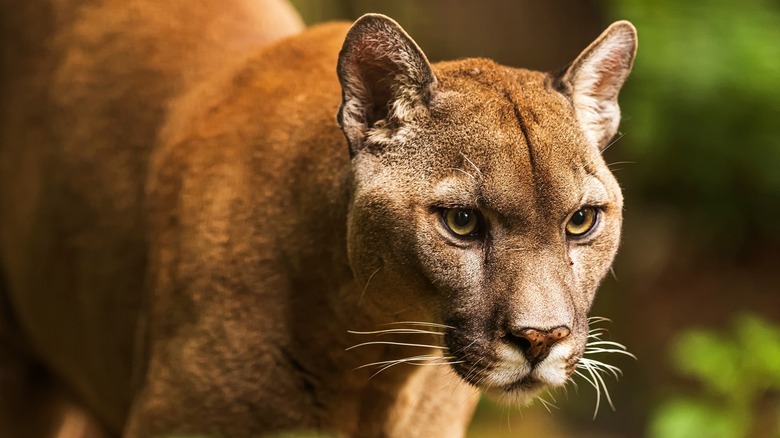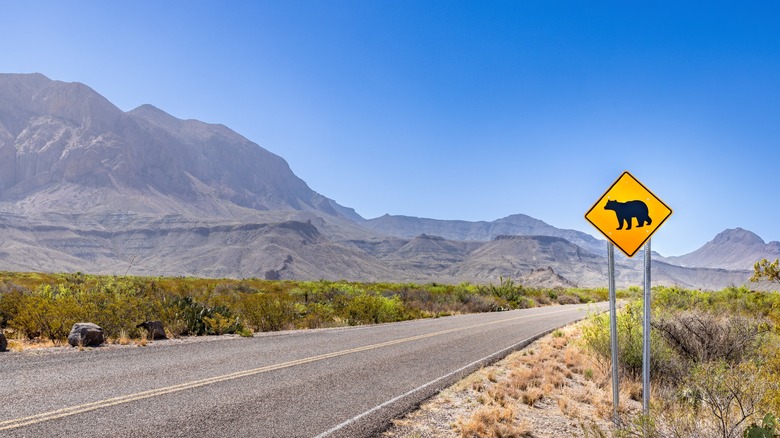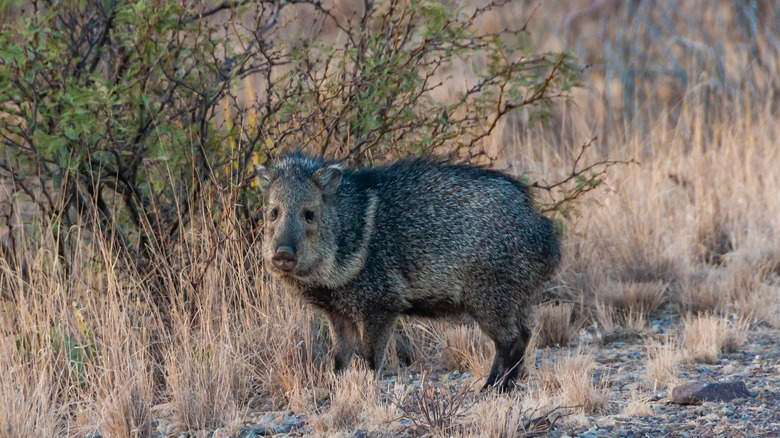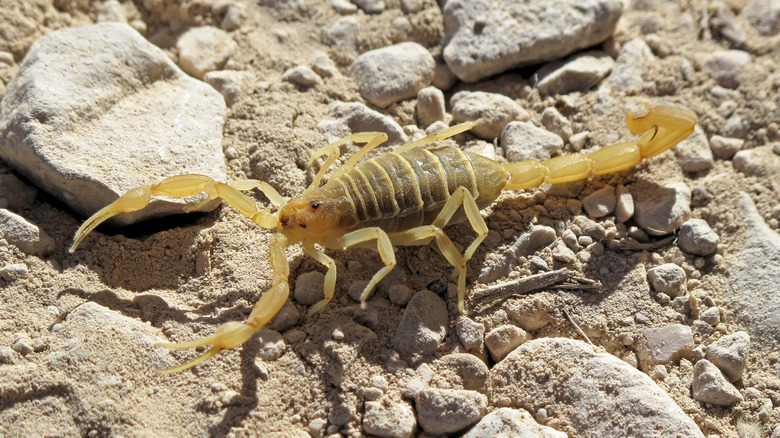5 Creatures To Beware Of When Adventuring In Big Bend National Park
Texas is a big state with wildly varied geographic features, many of which are remote and awe-inspiring. Big Bend National Park is one such place. This 1,200-plus-acre plot of the Chihuahuan Desert is situated on a large bend of the Rio Grande River — hence the name. Within the boundaries of the park are a variety of natural features — all of them rugged — as well as a myriad of fossils, plants, and animals. It is so diverse, in fact, it contains 193 distinct biogeographical zones or ecosystems. So, it is no surprise this natural wonderland draws over half a million visitors a year, despite its isolated location.
It certainly is a national park that should be on everyone's bucket list. However, due to its isolation, rugged terrain, and potential dangerous plants and animals, it is also one of the deadliest national parks in the United States. Here are a handful of creatures to beware of when adventuring in Big Bend National Park.
Mountain lions may become aggressive
Mountain lions, or cougars, are found throughout most of Texas. While it is hard to get an exact census, it is estimated a couple dozen mountain lions call Big Bend National Park home. While that number may not seem particularly intimidating, the National Park Service says more than 150 sightings happen each year. Since the 80s, some of these sightings have resulted in an attack. That is certainly concerning enough to warrant caution.
If you do happen to encounter a mountain lion while hiking or camping in Big Bend National Park, the best advice offered up by the NPS is to:
- Stay calm.
- Do not run.
- Maintain eye contact.
- Do not turn your back to the lion.
- Make yourself appear as large as possible.
- Back away slowly.
If the lion continues to pursue, it is suggested to throw rocks, sticks, or other objects in their direction. Yelling can also help deter a mountain lion from attacking. If the big cat does attack, however, fighting back is your best option. Any sightings — even those not involving aggressive behavior by the lion — should be reported to a park ranger or the park office.
Be cautious around black bears
Black bears in Big Bend National Park are somewhat of a natural oddity. Not because they are there, but because they weren't and are now once again. In what the National Park Service terms a rare repopulation, black bears, which had once been common in the Chisos Mountains, returned to this portion of their natural range in the 1980s after being eradicated from the region during the early- to mid-1900s. Today there are around three dozen black bears within Big Bend's boundaries and sightings are fairly routine.
The return of the black bears not only added to the biodiversity of Big Bend, but also the potential danger. Although black bear attacks are rare, there is always that possibility whenever someone is venturing through their domain. So before heading to Big Bend, make sure you are aware of what to do if you encounter or are attacked by a bear.
Encountering a black bear in Big Bend is no different than seeing one in any other part of their natural range. First and foremost, it is important to stay calm and, most importantly, do not run! Instead, maintain eye contact and slowly move away from the bear. If it begins an aggressive pursuit, use bear spray if you have it. If not, yell and throw rocks and sticks at it. If a black bear attacks, you should fight back! This is a much different approach than when attacked by a grizzly, but gives you a better chance at survival.
Snakes are plentiful and potentially dangerous
There are more than 30 varieties of snakes in Big Bend National Park, including some of the most dangerous snakes in the world (via National Park Service). While it's important to be able to tell the difference between venomous and non-venomous snakes, when exploring Big Bend, there are a handful of venomous species that you need to be able to identify. These potentially dangerous serpents include four types of rattlesnakes — western diamondback, Mojave, black-tailed, and mottled rock — and the trans-Pecos copperhead.
The majority of snake encounters in Big Bend happen when hiking. The best way to stay safe is to be well aware of your surroundings, paying particular attention when stepping over logs or rocks or when grabbing onto rocks or tree limbs. Additionally, do not handle any snakes you happen to come across — even if you believe them to be non-venomous.
If you do happen to get bitten, you should seek help immediately. As many parts of Big Bend are extremely remote, this can be difficult at times. If you have cell service, attempt to call 9-1-1 and/or a park ranger as soon as the bite occurs. Then, attempt to make your way back to your vehicle or to park headquarters.
Javelinas have the potential to attack
Javelinas, or collared peccaries, are found throughout most of South and West Texas. They are a very common sight within Big Bend National Park. They are usually seen in small groups in clearings in the evenings or in canyons, caves, or thick brush during the hotter mid-day hours. While javelina have a fearsome appearance and once had a (erroneous) reputation for aggressive behavior, attacks on humans are fairly rare. However, attacks do occur and javelina are capable of inflicting serious damage with their teeth and tusks (canine teeth).
Because they have poor eyesight, javelina often wander closer to humans than other animals found in the wild. This behavior is sometimes mistaken for aggression, but is typically just because they are not aware of the human presence. If a javelina begins to come uncomfortably close, the best thing to do is to make noise by yelling or screaming. Throwing rocks or sticks in their direction (not at) is another effective way to make them flee.
Scorpions can sting unsuspecting adventurers
Despite the diminutive size, scorpions have a fearsome look and the reputation to match. While Big Bend is home to 15 different species of scorpions, the National Park Service claims that the majority of park visitors never see one. That does not mean people aren't stung by scorpions. Indeed they are and the unseen scorpion is typically the one that does the damage.
The most common way stings occur is an unsuspecting hiker or camper puts on a pair of boots or shoes a scorpion has decided to claim as their home. So, the best precaution to prevent being stung is to be sure and check shoes or clothing before putting them on. It is also not uncommon for hikers and climbers to be stung when reaching for a handhold in a rocky crevice. Although it is not always possible, the best practice is to be able to visually scan where you put your hands to avoid not only scorpions, but also thorns and snakes.
One species of scorpion which inhabits Big Bend doesn't sting at all, but is best avoided nonetheless. The whip scorpion doesn't even have a stinger. Instead, it has the capability to shoot an acidic substance from its tail. While this is a defensive tactic that is rarely directed at humans, the park does issue warnings from time to time when the resident population of whip scorpions is particularly active.





